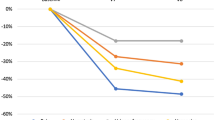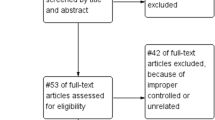Purpose:
To assess whether the topical use of steroids or 5-aminosalicylic acid (5-ASA) is superior to sucralfate in preventing acute rectal toxicity during three-dimensional conformal radiotherapy (3DCRT) to 76 Gy.
Patients and Methods: Patients undergoing 3DCRT for prostate carcinoma at our institution were offered to be randomized to sucralfate 3 g in 15 ml suspension enema (Antepsin®), mesalazine 4 g gel enema (Enterasyn®), or hydrocortisone 100 mg foam enema (Colifoam®). Randomization was blind to the treating physician but not to the patient. Sucralfate was chosen as control arm. Topical treatment had to be performed once daily, starting on day 1 of 3DCRT. Acute rectal toxicity was scored weekly according to RTOG criteria. Time to occurrence of grade 2+ acute rectal toxicity was taken as endpoint.
Results: The trial was opened in August 1999, and after the first 24 patients had been treated, arm 2 was discontinued because of eight patients receiving mesalazine, seven actually developed acute rectal toxicity (five patients grade 3 and two patients grade 2).
Until May 2001, 134 consecutive patients were randomly assigned to sucralfate (63 patients), mesalazine (eight patients) or hydrocortisone (63 patients). The cumulative incidence of acute rectal toxicity at the end of treatment by arm is 61.9 ± 6.1%, 87.5 ± 11.7%, and 52.4 ± 6.2% for arms 1, 2, and 3, respectively. The difference between the mesalazine group and the sucralfate group is highly significant (hazard ratio [HR] 2.5, 95% confidence interval [CI] 1.1–5.7; p = 0.03). At both uni- and multivariate analysis taking into account several patients and treatment covariates, the difference between hydrocortisone and sucralfate is not significant (HR 0.7, 95% CI 0.5–1.2; p = 0.2).
Conclusion: Topical mesalazine is contraindicated during radiotherapy. Hydrocortisone enema is not superior to sucralfate in preventing acute rectal toxicity.
Fragestellung:
Randomisierter Vergleich der lokalen Anwendung von Steroiden oder 5-ASA oder Sucralfat zur Prävention einer akuten Strahlenproktitis unter 3-D-konformaler Radiotherapie (3DCRT) bis 76 Gy.
Patienten und Methodik: Patienten, die sich in unserer Klinik wegen eines Prostatakarzinoms einer 3DCRT unterzogen, wurde randomisiert angeboten eine Vorbehandlung 1) mit Sucralfat (3 g suspendiert im 15-ml-Klysma), 2) Mesalazin als 4-g-Gelklysma) oder 3) Hydrocortison: 100 mg als Schaumklysma). Die Randomisierung zu einem dieser drei Studienarme war dem behandelnden Arzt unbekannt, nicht aber dem Patienten. Sucralfat wurde als Kontrollarm gewählt. Die jeweilige topische Therapie musste ab dem 1. Tag der 3DCRT einmal täglich durchgeführt werden. Auf akute Strahlenproktitis wurde jede Woche nach RTOG-Kriterien geprüft. Als Endpunkt wurde das Auftreten einer akuten Strahlenproktitis Grad 2 festgelegt.
Ergebnisse: Die Studie begann im August 1999. Nachdem die ersten 24 Patienten aufgenommen worden waren, wurde Arm 2 abgebrochen, da sieben Patienten unter Mesalazin eine akute Strahlenproktitis (Grad 3 bei fünf Patienten und Grad 2 bei zwei Patienten) entwickelten.
Bis zum Mai 2001 wurden 134 Patienten der lokalen Anwendung von Sucralfat (63 Patienten), Mesalazin (acht Patienten) oder Hydrocortison (63 Patienten) zugeführt. Die kumulative Inzidenz akuter Strahlenproktitis betrug jeweils 61,9 ± 6,1%, 87,5 ± 11,7% und 52,4 ± 6,2%. Der Unterschied zwischen Mesalazin- und Sucralfat-Gruppe ist hoch signifikant (HR: 2,5; 95%-CI: 1,1–5,7; p = 0,03), der zwischen Hydrocortison und Sucralfat nicht (HR = 0,7; 95%-CI: 0,5–1,2; p = 0,2).
Schlussfolgerung: Topisches Mesalazin ist unter Radiotherapie kontraindiziert. Hydrocortison-Klysmen und Sucralfat sind zur Prophylaxe einer akuten Strahlenproktitis gleichwertig.
Similar content being viewed by others
Author information
Authors and Affiliations
Additional information
Received: August 19, 2002; accepted: February 21, 2003
RID="*"
ID="*"Selected for oral presentation at 44th ASTRO Meeting, October 6-10, 2002, New Orleans, LA, USA.
Address for Correspondence Giuseppe Sanguineti, MD, Department of Radiation Oncology, University of Texas Medical Branch, 301 University Blvd, Galveston, TX 77555-0711, USA, Phone (+1/409) 747 2888, Fax 772 1856, e-mail: gisangui@utmb.edu
Rights and permissions
About this article
Cite this article
Sanguineti, G., Franzone, P., Marcenaro, M. et al. Sucralfate versus Mesalazine versus Hydrocortisone in the Prevention of Acute Radiation Proctitis during Conformal Radiotherapy for Prostate Carcinoma . Strahlenther Onkol 179, 464–470 (2003). https://doi.org/10.1007/s00066-003-1082-4
Issue Date:
DOI: https://doi.org/10.1007/s00066-003-1082-4




